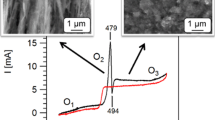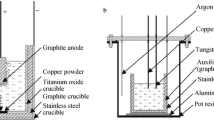Abstract
The influence of the F/Cl atomic ratio on the morphology of titanium metal, deposited by electrorefining in various alkali halide solvent mixtures and K2TiF6 solute, was investigated. A continuous transition from powdery deposits in chloride mixtures (F/Cl = 0), through dendritic deposits in chloride-fluoride mixtures (0 < C/Cl < ∞), to coherent and adherent deposits in fluoride mixtures (F/Cl = ∞), was evidenced. This dependence was explained in terms of the increase of the thermodynamic stability of TiF6 3− anion (and the consequent decrease of the activity of Ti3+, i.e. electrocrystallization centres available in the melt), with increase of the parameter F/Cl. This is supported by the observed increase in the decomposition potential, E d, and the shift of the Ti3+ discharge potential, E p, toward more negative values, in the same sequence. The influence of the F/Cl atomic ratio on current efficiency, η, on the grain size distribution and on the chemical purity of electrodeposited titanium metallic powder, was also discussed.
Similar content being viewed by others
Abbreviations
- cd:
-
current density
- E d :
-
decomposition potential
- E p :
-
discharge potential
- (E 1/2)c :
-
half wave potential of the complex
- (E 1/2)f :
-
half wave potential of the free ion
- η:
-
current efficiency
- d m :
-
average diameter
- P m :
-
molar polarizing strength
References
F. R. Clayton, G. Mamantov and D. L. Maning, J. Electrochem. Soc. 120 (1973) 1193.
J. de Lepinay and P. Paillere, Electrochim. Acta 29 (1984) 1243.
J. de Lepinay, J. Bouteillon and M. J. Barbier, J. Appl. Electrochem. 17 (1987) 294.
A. Robin, J. de Lepinay, M. J. Brbier, J. Electrochem. Soc. 125 (1987) 230.
L. P. Polyakova, Electrochim. Acta 31 (1986) 159.
Y. Qi-qin, Rare Metals of China 1 (1982) 38.
J. G. Wurm, L. Gravel, R. J. A. Potvin, J. Electrochem. Soc. 104 (1957) 301.
N. F. H. Bright and J. G. Wurm, Can. J. Chem. 36 (1958) 1615.
A. Robin and J. de Lepinay, Electrochim. Acta 36 (1991) 1009.
N. Ene and S. Zuca, Rev. Roumaine Chim. 36 (1991) 1238.
S. Zuca and N. Ene, Material Science Forum 73–75 (1991) 643.
N. Ene, PhD. thesis, Bucharest (1991).
G. Brauer (ed.), ‘Handbook of preparative inorganic chemistry’, Vol. 2, 2nd edn, Academic Press, New York (1965) p. 1163.
A. Calusaru, ‘Electrodeposition of metal powders’, Elsevier, Oxford (1979) p. 87.
G. W. Mellors and S. Senderoff, J. Electrochem. Soc. 112 (1965) 266.
J. Lumsden, ‘Thermodynamics of molten salts’, Academic Press, London (1966) p. 70.
B. J. Fortin, J. Electrochem. Soc. 106 (1959) 428.
M. V. Smironov, Izd. Sibir. Otd. Akad. Nauk. SSSR 10 (1959) 74.
G. Mamantov, J. Electroanal. Chem. 9 (1965) 253.
Cheng Guang-Sen, M. Okido and T. Oki, J. Appl. Electrochem. 17 (1987) 849.
C. A. C. Sequeira, J. Electroanal. Chem. 23 (1988) 203.
V. V. Nerubaschenko, Fiz. Khim. Elektrochim. Rasplavi Tverd. Electroliti 2 (1979) 65.
J. Heyrovsky and D. Ilkovic, Collection 7 (1935) 198.
V. I. Taranenko, I. V. Zarutskii, V. I. Shapaval, M. Makyta and K. Matiasovskiy, Electrochim. Acta 37 (1992) 263.
Author information
Authors and Affiliations
Rights and permissions
About this article
Cite this article
Ene, N., Zuca, S. Role of free F− anions in the electrorefining of titanium in molten alkali halide mixtures. J Appl Electrochem 25, 671–676 (1995). https://doi.org/10.1007/BF00241929
Received:
Revised:
Issue Date:
DOI: https://doi.org/10.1007/BF00241929




